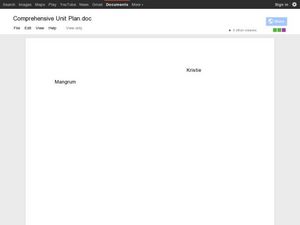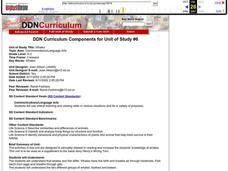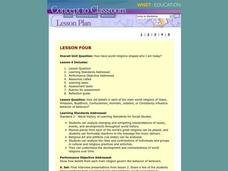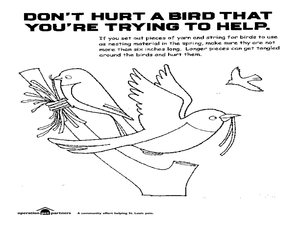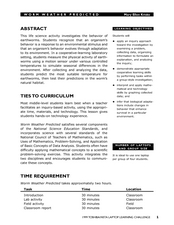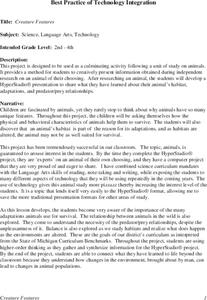Curated OER
The Life Cycle of the Mealworm
Fourth graders provide a habitat for live mealworms and observe their life cycle. In this animal life cycle and scientific inquiry lesson, 4th graders create a habitat for a live mealworm and observe and record related data as it grows....
Curated OER
Understanding Social Commentary
By learning how to identify and understand social commentary students can flex their critical thinking skills.
Curated OER
Hawaii's Freshwater Animals - Species Report
Students explore biology by creating a report for the class. In this oceanography lesson, students research and identify the survival characteristics of a list of freshwater animals by utilizing the Internet and library. Students...
Curated OER
Whales
Students compare the differences between whales and fish. They examine the differences of toothed and baleen whales. They identify behavioral and physical characteristics of animals that help them survive in their habitat.
Curated OER
The Circulatory System - Part I
First graders consider what effect their behavior has on their health. Students make a fist to indicate the size of his/her heart. They complete a worksheet on the heart, coloring the arteries red and the veins blue.
Curated OER
Manatee Endangered
High schoolers (or middle schoolers) research the endangered manatee and the Endangered Species Act. They choose a local animal that is threatened or endangered and attempt to find out what is being done to protect it. Short, but sweet,...
Curated OER
Discovering New Species
Students identify animals observed by Lewis and Clark while evaluating the animal's habitat and describing the animal's behavior. Students construct a food web mobile to illustrate the animal's position in the food web in the 19th...
Curated OER
How have world religions shaped who I am today?
Young scholars analyze changing and competing interpretations of issues, events, and developments throughout world history. They analyze the roles and contributions of individuals and groups in cultural and religious practices and...
Curated OER
Cloud in the Classroom
Students describe the relationship between animals and humans. In this biology lesson, students research about the history of horses in America. They present a mock news broadcast about their research.
Curated OER
This is for the Birds!
Pupils complete activities to investigate wild birds. In this bird study lesson, students make a wild bird feeder to examine the proper ways to care for wild birds. Pupils explore organizations in their community that help wild birds and...
Curated OER
Hector's World Cyberbullying: You're Not Alone
Students watch an episode of Hector's world regarding cyber-bullying and begin to understand what hurtful actions are in relation to someone's feelings. In this Cyber-bullying lesson, students are introduced to the idea of good character...
Curated OER
Spatial Characterization of Animal Movement
Students identify biotic and abiotic factors which may alter the observed patterns in plant communities with different structural characteristics, climate, or environmental constraints.
Curated OER
Making Tracks
Fifth graders examine the fossil footprints of two and four legged dinosaurs. Using this information, they try to determine how the dinosaurs lived their lives. They use their own walking pattern to compare it to the dinosaurs and...
Curated OER
Beaver Ecology
Students explore the lives of bgeahvers. They identify the physical and behavioral adaptations that help beavers survive in their environment. Students compare and contrast how beavers influence the ecology of both forest and aquatic...
Curated OER
Stimulus Response
Students explore the five steps in the stimulus-response pathway. They analyze the senses and the difference between animals' primary and secondary senses. Students collect information about animal behavior to debate the ethics of...
Curated OER
The Beagle Brigade
Students brainstorm how to handle conflict scenario. In this character education lesson, students read a story and respond as to how the characters should handle the conflict. Students examines feelings of characters and...
Curated OER
Worm Weather Predicted
Students examine worm habitats. In this animal habitats lesson, students participate in a lab activity that requires them to explore the adaptations that earthworms make to their environment.
Curated OER
Desert Animals
Young scholars survive within an ecosystem, an animal must be physically and behaviorally adapted to the conditions of its environment.
Curated OER
Footprint Detectives: Making Inferences Using Dinosaur Trackways
Students analyze and discuss footprints and dinosaur tracks. They listen to books about paleontologists, create and analyze their own trackways using black paper and chalk, examine the data, and form hypotheses about footprints and...
Curated OER
Creature Features
Students investigate animals and how they adapt to their environment. They design a multimedia presentation that includes information about an animal of their choice. They include a title card, habitats, adaptations, and a predator/ prey...
Curated OER
Frog Metamorphosis
Students play 20 Questions with animal characteristics and then view an animation of how a tadpole changes into a frog. They consider the importance of camouflage to frogs and write out the story of a frog from tadpole to adult.
Curated OER
Desert Animals
First graders investigate and identify a variety of animals that live in the desert. They complete a class KWL chart, then listen to the book Way Out in the Desert. Next, 1st graders observe a presentation of live desert animals, and...
Curated OER
Safety and Injury Protection
First graders identify safety rules for passengers and pedestrians and explore school bus safety. They also complete a picture illustrating a school bus safety rule, as well as, discuss bus behavior rules.
Curated OER
Understanding Science Vocabulary And Categorization
Pupils explore and examine scientific language and categorization as related to commonly known plants and animals. They hypothesize about a specific plant or animal, how it was scientifically named, what concepts and vocabulary is...


